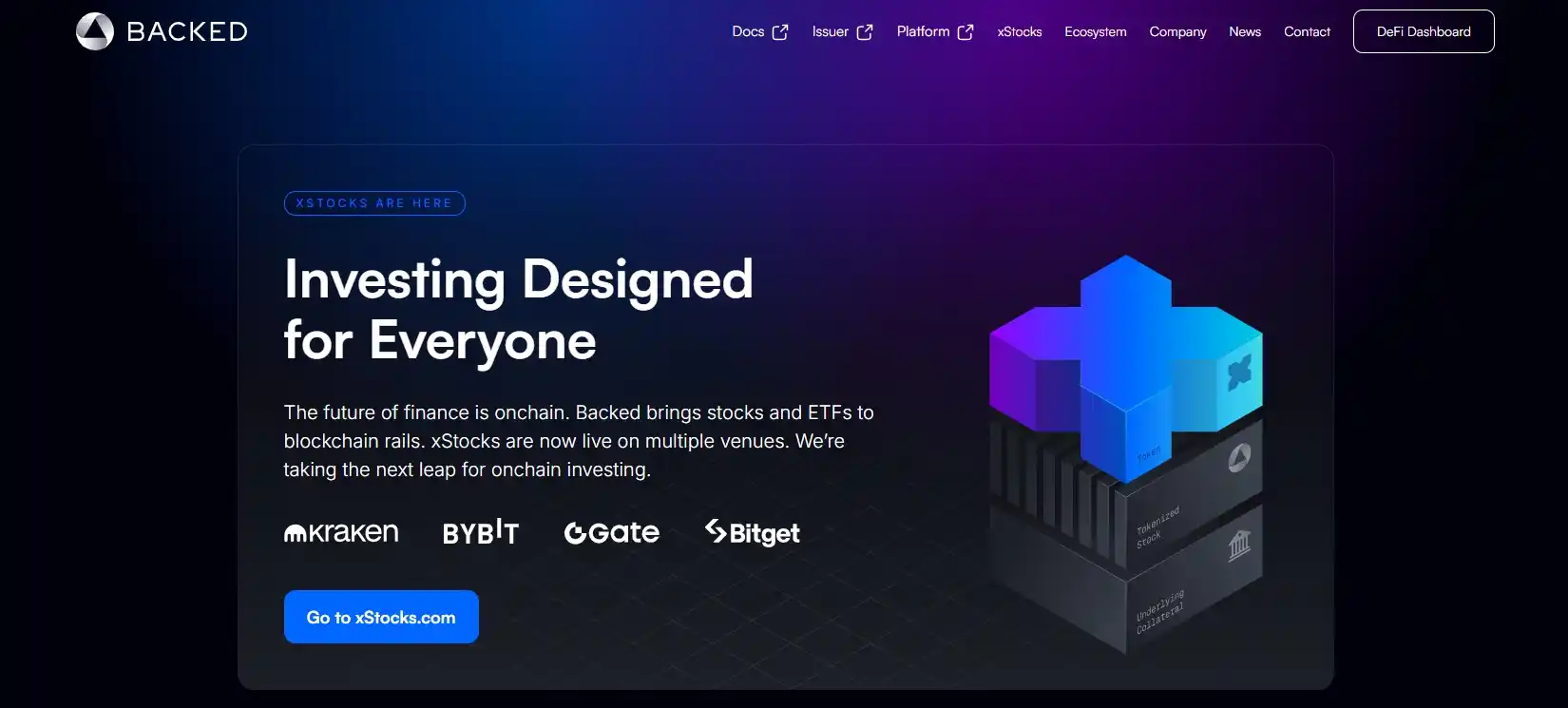Backed Finance is an innovative platform that bridges traditional finance with decentralized technologies. The project specializes in creating digital counterparts of real-world assets such as stocks, bonds, and ETFs in the form of blockchain tokens. This allows investors to access traditional markets through crypto wallets, bypassing complex KYC procedures and limitations of conventional exchanges.
With Backed Finance, users can trade tokenized assets (bTokens) 24/7, ensuring liquidity and transaction transparency. The platform operates on Ethereum and other compatible networks, making its integration with the DeFi ecosystem seamless.
Contents:
- What is Backed Finance?
- How does asset tokenization work?
- Platform advantages
- DeFi integration and growth prospects
- Security and regulation
- Conclusion
What is Backed Finance?
Backed Finance is a decentralized protocol that converts traditional financial instruments into digital tokens. The project's main goal is to eliminate barriers between conventional markets and the crypto economy, providing users access to assets previously unavailable in blockchain environments.
The platform issues bTokens, each backed by real assets held by regulated custodians. This ensures digital tokens are fully collateralized by physical assets, reducing risks for investors. Backed Finance supports a wide range of assets including S&P 500 stocks, gold, and government bonds.
bTokens' utility lies in their compatibility with popular DeFi protocols. Users can participate in staking, provide liquidity, or use tokens as collateral without interacting with traditional financial institutions.
How does asset tokenization work?
The process of converting real assets into digital tokens involves several stages. First, the selected asset (e.g., Apple stock) is deposited with a licensed custodian. Then Backed Finance issues corresponding bTokens that mirror the underlying asset's value.
Key features of the tokenization mechanism:
- Full collateralization — each bToken is 1:1 backed by real assets.
- Transparency — all reserves undergo regular audits.
- Liquidity — tokens can be freely traded on DEX and CEX platforms.
- Accessibility — no minimum entry threshold.
After issuance, tokens are distributed to investors through partner exchanges or directly via the platform. Their value correlates with the underlying asset price, and holders can redeem them at any time.
Platform advantages
Backed Finance offers unique features that differentiate it from competitors. First, it provides direct access to global markets without requiring brokerage accounts. This is particularly valuable for users in regions with limited access to traditional financial services.
Second, integration with DeFi enables bTokens' use across various decentralized applications. For example, tokenized stocks can be utilized in yield farms or as loan collateral.
Additionally, Backed Finance minimizes fees through process automation. Unlike traditional exchanges where each operation incurs additional costs, bToken transactions are executed with minimal expenses.
DeFi integration and growth prospects
Backed Finance actively expands collaborations with leading DeFi protocols, significantly increasing tokenized assets' utility. Strategic partnerships enable bTokens' integration into various DeFi mechanisms, from liquidity provision to collateral usage.
| Protocol | Interaction format | User benefits |
|---|---|---|
| Uniswap | Liquidity pools | Ability to trade bTokens with minimal slippage |
| Aave | Collateral assets | Obtaining loans against tokenized stocks |
| Curve | Stable swaps | Efficient exchange between different bToken types |
This deep integration creates new earning and portfolio management opportunities for investors. The project's roadmap includes connecting additional DeFi platforms, making Backed Finance's ecosystem even more versatile. Development prospects include supporting new asset classes and entering institutional markets through regulated financial instruments.
Security and regulation
Backed Finance prioritizes user asset protection and regulatory compliance. All tokenized assets are stored with licensed custodians with impeccable reputations, ensuring full collateralization. The platform regularly undergoes independent smart contract audits by leading blockchain security companies, minimizing technical risks.
From a regulatory standpoint, the project fully complies with European standards including MiCA (Markets in Crypto-Assets). This ensures legal transparency and investor protection. The Backed Finance team actively collaborates with regulators to expand service geography while maintaining high compliance standards.
Conclusion
Backed Finance represents a significant step in converging traditional finance with blockchain technology. The platform not only simplifies global market access but also expands asset utilization possibilities in DeFi.
With its transparency, security, and extensive crypto ecosystem integration, the project has strong potential to become a key player in tokenization. In coming years, we can expect further growth in supported assets and bToken liquidity, making them even more attractive to investors.





